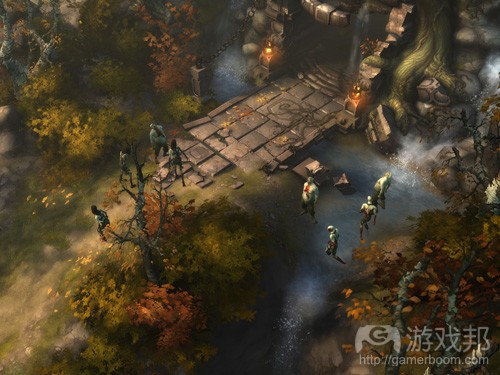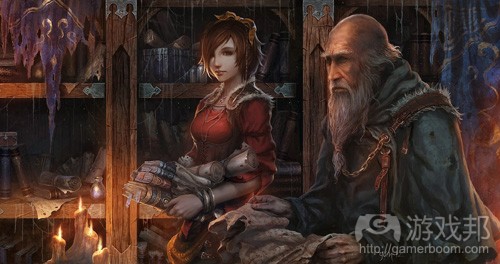分析《暗黑破坏神3》故事设计的失败之处
作者:Josh Bycer
作为一种艺术形式,故事写作其实是大多数游戏的软肋。从我个人来说吧,比起优秀的游戏故事我更加看重游戏玩法。而因为我花了大把时间在玩《暗黑破坏神3》,所以我便能够正视这款游戏的故事,并最终发现它并不如《暗黑破坏神2》。
《暗黑破坏神3》所存在的一些问题源于其糟糕的故事设置。《暗黑破坏神3》并不是唯一犯了这种错误的游戏,但是它却是最新一款大家所熟悉并出现了这些问题的游戏。以下我提到的内容可以说是对这款游戏的剧透,所以如果你未玩过这款游戏就不要阅读这些内容:
1.错误的世界逻辑
创造科幻环境所存在的最大挑战之一便是定义世界规则。在现实世界中,写作者已经注意到了这一点。但是当我们面向科幻世界时却常常会产生一种误解,即因为世界是虚拟的,所以在此之中的所有事物也都不需要具有意义。
如果故事的前10分钟已经声明只有半兽人才拥有魔法,但是随后的2小时又说每个种族都能够施加咒语,那这便是一种偷懒的写作方式。优秀故事写手的一大特点便是能够创造出与现有规则保持一致的宇宙或环境。
每一部《哈利波特》都为我们很好地呈现出了科幻世界的运转方式。该故事以霍格沃兹魔法学校为背景,并且主角和观众都非常清楚地看到故事中所设定的规则。例如药剂的作用,如何投射咒语以及社会中的法律等。
设置世界逻辑并不意味着你需要向观众解释清楚每个步骤的运行,你只要阐明一个重要的环节便可。就像我是宫崎骏(游戏邦注:日本知名动画导演,动画师及漫画家)的忠实粉丝,其电影的一大魅力便来自于背景设置。每部电影都发生在一个非常独特的背景下,并且也都拥有自己的规则,法律和人。而故事也从未真正向观众解释整个世界是如何运转的,只是让观众清楚那些与故事和角色相关的内容。
基于这一点让我们将注意力再次转回《暗黑破坏神3》。这款游戏所存在的问题便在于游戏从未向玩家解释整个世界的逻辑,或者这些逻辑与游戏故事并不相符。
首先游戏并未解释为何敌人能够复苏:在之前游戏中被杀死的“屠夫”,“堕落天使”以及“骷髅王”会在之后再次回到游戏中。《暗黑破坏神》虽然让Leah重生了,但是在玩家的理解中恶魔们死去后便不会再复苏了。
说到“骷髅王”,他在《暗黑破坏神3》的情节中的出现更是漏洞连连。为什么他是玩家遇到的第一个鬼怪?受他诅咒的人最后会怎样?为什么王冠对于打败他如此重要?
罪恶之心的全部意义是什么,为何只存在两颗罪恶之心?游戏将不同对象和人带进故事中,但是它们却从未解释这些对象和人的重要性。例如发射机怎样才能阻挡整个恶魔军队的进攻,或者为何我们需要拯救希望天使?
如果游戏未能解释清楚情节元素,便会导致各种情节漏洞和逻辑矛盾的出现,并最终破坏了整个故事。更糟糕的是如果游戏未能明确游戏世界的背景故事,那么写作者便只能在原本摇摇欲坠的游戏基础上添加更多层面,这也是我们接下来将提到的内容。
2.回溯连续性
我们总是很难设计拥有多个部分的故事,尤其是在作者需要确保故事情节向前发展的时候。较常见的问题便是作者会回到之前的情节点上,以一种不同的意义再次将它们带进故事中。例如英雄会发现自己至始至终都是“被选中的对象”,但是直到某一时刻他才真正意识到这一点。
或者:英雄的朋友其实一直都很讨厌英雄,并且只是在利用英雄而已,而且现在还想在背后捅他一刀。观众已经忍受不了这种烂情节了。
《暗黑破坏神3》便是通过Nephalem表现出了让人困惑的回溯连续性。根据游戏的描述,我们知道Nephalem是远古而来的天使和恶魔之子。他们拥有超级强大的人类力量,并且是这个游戏中的被选中的主角。
但是从《暗黑破坏神》的世界建立来看,这根本毫无意义。在之前的游戏中,英雄总是一些接受了超自然培训的普通人类,并担负起拯救世界的任务。是否在《暗黑破坏神》中Nephalem便是英雄?如果是这样的话为何在之前的两部游戏中却从未提及这一点?
游戏只会围绕着这些情节点而展开。在到达60级的法力前玩家并不能获得任何特殊能量去表明自己就是Nephalem。而这么做只会让玩家觉得游戏故事极端乏味。玩家选择角色只是根据他们是否是Nephalem而不是基于他们的职业。
除此之外我们也能从Adria身上感受到回溯连续性,她将出现在第三幕的最后,使用禁忌武术摧毁整个军队,Tryeal以及玩家所处的地面。但是之前当我遇到Adria时,她却从未表露出自己拥有魔法的样子,并且在这次事件后她也会继续保持默默无闻状态。而作者却赋予了她一分钟的特殊法力去推动整个故事情节的发展——这也是该游戏故事的另一大缺陷。
3.松散的故事线程
当作者需要投入更多工作去创造一个故事时,他们便会考虑到未来的发展而暂时搁置情节点。但是问题就在于作者可能会彻底忘记这些情节点的存在,未能为这些故事元素收尾。
在多部分故事中共有两种类型的情节点:元点和局部点。元点是那些与宇宙或大情节相关的点:例如在《指环王》中Sauron掌控了大局,在《星球大战》中帝国受到威胁等。局部点则是指故事特定章节中的某些内容:例如Helm’s Deep战役以及Rebels打败第一个克星。
同时我们还需要注意的是必须在情节结束前通过某种方法解决局部情节。最让人纠结的便是作者保留多个完全开放的情节,试图在今后的续集中再解决这些问题。
关于作者合理设置情节点的一大例子便是《复仇者联盟》。每一部电影都有与主角情境有关的局部点。在电影的最后所有与局部情节有关的要点都得到了解决,但是与“复仇者”相关的点却可等待后续电影再作解释。
《哈利波特》也是一个典型的例子:每一部电影都为我们呈现出主角在霍格沃兹1年中的生活,并基于此展开情节陈述。而在整个系列电影中还将笼罩着更大的情节,即伏地魔与正面巫师之间的较量。
《暗黑破坏神3》中缠绕着许多线头,但是作者却并不想去清理它们:例如第一幕中盗贼的威胁以及Adria的命运等等。显然暴雪保留了这些点是想要在之后进行扩展,但是如此看来更像是偷工减料的表现。
相比之下《暗黑破坏神2》的结局较为完整。在玩家打败暗黑破坏神后局部点便完成了,而解决太阳神并拯救世界的元点则留给了之后的扩展内容。如此的设置在《暗黑破坏神2》中非常合适,因为在整个游戏过程中玩家的主要任务便是击败暗黑破坏神,并且所有情节点也是围绕着这一点而展开。
但是在《暗黑破坏神3》中所有的点都未得到合理的解释。而如果作者愿意将它们当成游戏的局部点的话,问题也将得到解决。
4.Leah的结局以及女性代表
Leah应该算是暴雪最大的情节点:她出现在整个故事的所有过场动画及故事的下一章节。但是Leah的角色发展却永远不会超越游戏中的对象。她只能在游戏中使用一把钥匙去打开下一个游戏章节。
即使与Leah进行对话我们也不会将其当成游戏角色看待,我们只会认为她只是在不断阐述过去的事件以及自己如何不相信现实情况。而我们在游戏最后发现其实Leah是暗黑破坏神的女儿这一事实也并不重要,因为她已经被暗黑破坏神所控制并斩断了自己今后的发展。
所有的这些点便是该游戏另一个糟糕故事安排的表现:引入一个女性角色只是想要表达女性角色的存在罢了。也就是说Leah在游戏中的存在毫无意义,我们可以随便用任何魔法对象取代她(如黑灵石)。而《星际争霸》中的Kerrigan则是一个非常优秀的角色设计,并且最终成为了《星际争霸》主题中的关键点。
Leah设置存在的另一大问题便是违背了《暗黑破坏神》的宇宙主题:堕落。游戏的背景以及之前的游戏都是关于好人遭到侵蚀而衍生出了邪恶力量,包括Leoric,Tal Rasha,黑暗流浪者以及《暗黑破坏神1》中的盗贼。让玩家根据占有物选择从“善良”转变成“邪恶”却是一种糟糕的讲故事方式。
如果Leah在游戏过程中变坏了并背叛了团体,而不是由她妈妈颁布一个酝酿多年的计划,那么游戏是否会更有深度?更重要的是设计师便能够因此创造一个新的威胁而不只是引入另一种形式的暗黑破坏神。
不管是新图像引擎还是平台都不能够取代故事发展在游戏中的意义。就像我上述所提到的,一个优秀的故事虽然不能拯救一款糟糕的游戏,但是它却能够提升游戏质量并使它成为经典。(本文为游戏邦/gamerboom.com编译,拒绝任何不保留版权的转载,如需转载请联系:游戏邦)
Bad Story Writing in Games: Featuring Diablo 3
Josh Bycer
Story writing is an art-form in and of itself, and one area where most games falter. Personally, I always prefer great gameplay over a great story. But a game with an amazing story can turn a good game, into an excellent one. With all the time spent playing Diablo 3, I had a chance to examine the story and in my opinion it doesn’t compare to Diablo 2.
Diablo 3 featured several problems that are inherent of bad story telling in general. Now, Diablo 3 isn’t the only game that has made these mistakes, but it’s the most recent one and a game I’m sure a lot of people have played. Of course, what follows is open season for spoilers so if you haven’t played Diablo 3 yet, you may want to avoid reading this.
1. Faulty World Logic:
One of the biggest challenges when creating a fantasy setting is defining the rules of the world. In a real world setting, the writer already has this taken care of. But a misconception is that just because the world is based in fantasy that things don’t have to make sense.
If in the first 10 minutes the story declares that only Orcs can use magic, then having every single race cast spells two hours in is an example of lazy writing. One of the hallmarks of a great writer is being able to create a universe or setting that stays consistent in the rules established.
Each Harry Potter movie did a good job in showing how the world works. By taking place in Hogwarts, it allows both the main characters and the audience to see firsthand the rules of the setting. How potions work, spells are cast and the laws of the society for example.
Now, setting up world logic doesn’t mean you have to explain how everything works to the audience, only the relevant parts matter. For example, I’m a huge fan of the works of Miyazaki and one area that his movies excel in, is the setting. Each movie takes place in a completely unique setting with its own rules, laws and people. The stories never truly explain how the entire world works, only the parts that fit into the narrative and character’s lives.
In Howl’s Moving Castle, Howl knows a number of people from before the events of the movie, but the audience is never told just exactly how he knows these people. Instead, we find out their motivations for how they respond to Howl in the present and how it affects the world.
With that said we can turn out attention to Diablo 3 for this point. The problems with Diablo 3 are that the logic of the world is never really explained or fits with the narrative.
First off, it’s never explained why returning enemies: The Butcher, Izual, and The Skeleton King were brought back to life after being defeated in previous games. Diablo gets a pass for being reborn in Leah’s body, but it’s to our understanding that once a demon is killed, they’re gone for good.
Speaking about the Skeleton King, his whole appearance in Diablo 3 is full of plot holes. Why is he a ghost for the first encounter? What happened to the person he cursed? And why is the crown so important to defeating him?
What was the entire point about the sin hearts, and why were there only two of them? The game throws different objects and people into the story, but they’re never explained why they are important. What exactly did the catapults do that would turn back an entire army of demons for instance. or why we needed to save the angel of hope?
The more plot elements that aren’t explained, leads to plot holes and logical inconsistencies that can ruin a story. What’s worse is that if the back-story of the world isn’t set, it can lead to the writers adding more layers to an already shaky foundation, which takes us to the next point.
2. RetCon:
Multi- part stories can be tricky to design, as the writer needs to keep the plot moving. A common pitfall that can happen is the writer going back over previous plot points to reintroduce them into the story with a different meaning. The hero finds out that he was the chosen one all along but didn’t know it until this very moment for example.
Or: the hero’s best friend actually hated them the entire time and was just using the hero and now wants to back-stab them. This point reeks of bad writing and the audience can collectively groan when the writer uses this point.
Diablo 3 features a very confusing retcon in the form of the Nephalem. According to the game, these are the children of angels and demons from a long time ago. They supposedly have super human powers and are set up as the game’s version of the chosen one.
This doesn’t make sense, considering how the world of Diablo was set up. In previous games, the heroes have always been regular humans who were trained in supernatural professions, and they were able to save the world. Were they really Nephalem the entire time? And if so, why did no one mention this at all over the last two games?
For all the buildup around this plot point, it never goes anywhere. The player is never given any special powers to show that they are Nephalem outside of the level 60 magic find buff. All this point is used for, is to make the player’s connection to the story very dry. Every character refers to the player as a Nephalem, instead of by their profession.
Another retcon has to do with Adria, who at the end of act 3 uses demonic magic to wipe the floor with an entire group of solders, Tryeal and the player. Whenever we met Adria, she has not shown any use of magical powers, nor does she show any after this event. But for the writer’s sake, for one minute she is given special powers to move the plot along and it is another weak point in the game’s story.
3. Loose Threads
When creating a narrative that will be developed over multiple works, writers like to leave plot points open for future development. The problem is when writers completely forget to wrap up story elements and forget that they exist.
In multi-part stories, there are two types of plot points: Meta and local. Meta points are those relating to the universe or grand plot: Sauron taking over in Lord of the Rings and the empire as a threat in Star Wars for example. Local points are those localized in the specific chapter of the story: The battle for Helm’s Deep and the Rebels fighting the first death star for instance.
The important point to remember is that local plots have to be resolved in some way by the end of the plot. One of the biggest annoyances is when writers leave multiple plot points completely unresolved to be answered in future sequels.
An example of writers getting it right would be the build up to The Avengers. Each movie has the local plot of dealing with the main character’s situation. But there are mentions and little remarks about the Meta plot of the continuity between the movies that led to The Avengers. All points dealing with the local plot are resolved by the end of the movie, but the points that had to do with the Avengers were left open for that movie to explain them.
Harry Potter is another great example: each movie dealt with a year of being in Hogwarts and had a plot based on it. Then there was the larger plot of the war between Voldemort and the good wizards that loomed over the entire series.
Diablo 3 is full of loose threads that the writers made no attempt to clear up: The thieves’ guild threat in act 1, Covetous Shen’s mysterious objects and Adria’s fate. It’s obvious that Blizzard is saving those points for expansions, but it still reeks of lazy writing.
Diablo 2 ended with a more complete plot. At the end the local plot of defeating Diablo was finished, but the Meta plot of finishing off Baal and saving the world was reserved for the expansion. It worked in Diablo 2, because throughout the course of the game, the player’s main task was to beat Diablo, and that’s where all the plot points focused on.
But in Diablo 3, those points mentioned above, were left up in the air with no attempt to explain their purpose. If the writers would have referenced them in an attempt to wrap them up for the local point, then there wouldn’t have been a problem.
4. Leah’s end and the token female:
Leah was supposed to be Blizzard’s big plot point: featured in all the cut scenes and the next chapter in the world’s story. But, Leah’s character never grows beyond an object in the game.
Her only use in game is as a key to opening up the next part of the game.
Conversations with her never develop her as a character as they deal with her talking about past events and how she didn’t believe that this could happen. The big reveal at the end where we find out that she is Diablo’s daughter doesn’t matter by the fact that she becomes possessed by Diablo and robbed of any further character development.
All these points do is show another example of bad storytelling: introducing a female character whose only reason is to be a female character. Leah served no purpose to the game, as she could have been replaced by a magical object (such as the black soulstone) without missing a beat. Kerrigan from Starcraft was a better developed character who became a major point in the Starcraft mythos.
The other problem with how Leah turns out is that it goes against the theme of the Diablo universe: corruption. The back-story and previous games are all about good people being corrupted and turned towards evil: Leoric, Tal Rasha, the dark wanderer, the rogues from Diablo 1 etc. Having someone just flip a switch from “good” to “evil” in the form of a possession was weak storytelling.
What would have been a much deeper reveal would be if Leah over the course of the game became evil on her own and betrayed the group, instead of her mother enacting a plan, years in the making. More importantly, it would allow the designers to create a new threat instead of just reintroducing another form of Diablo.
By making the main enemy the possession by Diablo, it completely invalidates Leah as a character and any meaning she is supposed to have in the game.
All the new graphics engines and platforms available are not substitutes for story development. As mentioned above, a great story won’t save a horrible game, but it can help elevate a game from being good, to a classic.(source:chronicgamedesigner)









































 闽公网安备35020302001549号
闽公网安备35020302001549号